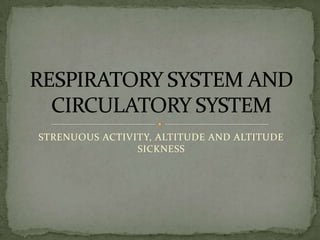
Respiratory system and circulatory system in high altitude
- 1. STRENUOUS ACTIVITY, ALTITUDE AND ALTITUDE SICKNESS
- 2. When he is climbing the mountain:
- 3. RESPIRATORY SYSTEM INCREASED LUNG VENTILATION Aerobic training results in a more efficient and improved lung ventilation. Lung ventilation is increased because of increased tidal volume and respiratory frequency.
- 4. RESPIRATORY SYSTEM INCREASED MAXIMUM OXYGEN UPTAKE Maximum oxygen uptake is improved as a result of aerobic training – it can be improved between 5 to 30 %. Improvements are a result of: - Increases in cardiac output - Increase number of red blood cells - Oxygen uptake difference - Muscle capillarisation - Greater oxygen extraction by muscles
- 5. RESPIRATORY SYSTEM INCREASED ANAEROBIC OR LACTATE THRESHOLD Lactate threshold changes as a result of endurance training. As a result of improved oxygen delivery & utilization, a higher lactate threshold (the point where oxygen supply cannot keep up with oxygen demand) is developed.
- 6. RESPIRATORY SYSTEM Changes during Exercise -Blood flow/min is increased from 5L/min to about 2530L/min. -The total amount of oxygen entering the lungs increases from 250ml/min at rest to about 4000ml/min. -Carbon dioxide removal increases from 200ml/min to about 8000ml/min.
- 7. CIRCULATORY SYSTEM Heart rate increase Stroke volume increase Cardiac output increase Blood flow-blood are shunted away from major organs such as kidney, liver, stomach, intestine Blood pressure increase The difference in oxygen content of arterial and venous blood increase
- 8. When he reached the highest peak:
- 10. RESPIRATORY SYSTEM Size of lungs increase to facilitate the osmosis of oxygen and carbon dioxide. Increase in the vascular network of muscles which enhances the transfer of gases. Increase in breathing and heart rate. Pulse rate and blood pressure increase as our hearts pump harder to get more oxygen to the cells. Change in oxygen affinity of blood. The rate of miscarriages is usually higher at altitudes above two miles because fetuses receive less oxygen from their mothers.
- 11. CIRCULATORY SYSTEM The circulatory system cannot work as efficiently, because there is less oxygen and carbon dioxide Heart rate increase Dilation of coronary arteries Cardiac contractility increase After being at a high altitude for a long time, the body will adapt. It will produce more red blood cells so that it can pick up more oxygen, since less oxygen is carried by each haemoglobin at high altitudes.
- 13. ACUTE MOUNTAIN SICKNESS (AMS) AMS usually occurs above 8,000 ft. (2,400 m) It is caused by reduced air pressure and lower oxygen levels at high altitudes. The symptoms of AMS are sleeping difficulty, dizziness, fatigue, headache, loss of appetite, nausea or vomiting, rapid pulse (heart rate) and shortness of breath with exertion.
- 14. TREATMENTS FOR ALTITUDE SICKNESS (AMS) Descend to lower altitude or stay at current altitude to see if his or her body adjusts Give aspirin or ibuprofen (Advil, Motrin) for headache Give oxygen, if available Avoid narcotics/smoking Keep the person warm and have him or her rest Give plenty of liquids (but not alcohol)
- 15. HIGH ALTITUDE CEREBRAL EDEMA (HACE) HACE has occurred from 10,000 ft. and above. It occurs when AMS is overlooked and thus brain swelling increases. In extreme cases, death can result. The symptoms of HACE are imbalance, severe headache, vomiting, nausea, and hallucinations.
- 16. HIGH ALTITUDE PULMONARY EDEMA (HAPE) HAPE has occurred from 8,000 ft. and above It occurs when excessive blood pressure causes fluid to leak from the blood vessels into the alveoli sacs of the lungs. The body compensates by increasing heart rate and blood pressure, thereby forcing more fluid into the lungs. The fluid in the lungs blocks the oxygen-blood interface. If altitude is not decreased, the victim drowns because no oxygen reaches the lung/capillary interface. The symptoms of HAPE are difficulty in breathing, gurgling sound in lungs, fever, coughing, and exhaustion
- 17. TREATMENTS FOR ALTITUDE SICKNESS (HACE AND HAPE) Descend to a lower altitude as soon as possible. Even a 1,000-2,000 feet (305-610 m) descent can dramatically improve one's symptoms. Oxygen therapy . If available, the patient can be placed in a Gamow bag, which is a portable high-pressure bag that increases oxygen tension and may stabilize the patient. Use of medications such as: -Dexamethasone (steroid) that reduces swelling of the brain. -Diamox that signals the brain to breathe more by correcting the imbalance chemical in the blood. -Nifedipine that decreases the narrowing of the artery that supplies blood to the lungs and help to reduce chest tightness.
- 18. Gamow bag
- 19. MEN VS WOMEN Professor Damian Bailey, from the University of Glamorgan, who will lead the research, believes female brains are better equipped to deal with a lack of oxygen. The decrement of maximum aerobic capacity at 4350m was less in women than in men under similar modes of ascent. Men are at greater risk of altitude sickness than women, as men tend to get HAPE more frequently than women Normal dietary iron intakes are adequate to support increased hemoglobin synthesis for males at high altitude, but females exposed to high altitude may benefit from a dietary iron supplement.